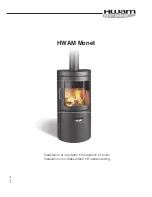
50
5 - USE
programmed to start the heater
when the room temperature drops
below 47°F (8°C)
If the heater will not be used for a
prolonged period (over one year) we
recommend draining the heating
and domestic circuit using the
procedure described in chapter 4.7
and 4.8, and closing gas supply
cock.
5.14 - Precautions
against freezing
The heater is not protected against
freezing. If the heater is switched
off and there is the possibility of
exposure to temperatures below
32°F (0°C), the system must be
drained as follows:
Carry out the procedure for
draining the domestic water
circuit described in chapter 4.8.
Carry out the procedure for
draining the heating circuit
described in chapter 4.7.
5.15 - Flue gas
discharge
This heater has high efficiency and
emissions with low pollution levels.
For this reason, especially in the
winter, white smoke will come out
of the discharge pipe. This is not a
cause for worry, as it is only steam
which condenses in contact with
the cold air.
5.16 -
Abnormalities
during operation
If the heater fails to start, check
that:
The gas supply is open;
The main electrical power switch
is in the on position;
The selector “4 “ is not in the off
position “A”;
The heater is not in the lock-out
state (red light “E” is ON)
If during winter operation the
domestic hot water works but the
heating doesn’t, check that:
The room thermostat is
programmed for a higher
temperature than that of the
room where it is installed, and
that it is programmed to call for
heating (setback thermostats)
any valves installed on the
heating supply and return
connections are open;
Selector “4” is turned to position
“C” or “D” to call for heating;
Selector “3” is at least at 140°F
(65°C);
Open the radiator valves to bleed
the air;
CAUTION!!!
If after these
checks the heating system is still
cold, do not attempt to repair it but
call a qualified technician.







































